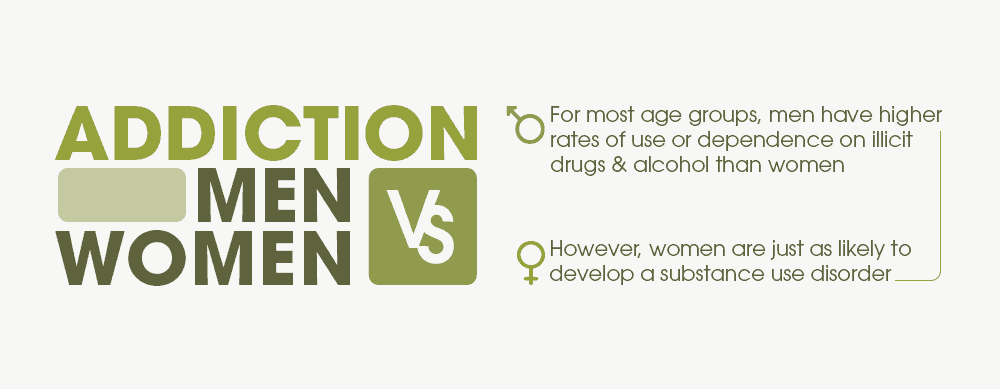Addiction Is More Common Than Most Think
Addiction is an under-acknowledged occurrence in our society. With the widespread prevalence of prescription medication, advertisements for drug treatment centers, and a high rate of incarcerated drug users, many are led to believe that drug addiction is being kept under control. This is quite the contrary, and America’s addiction problem has been largely swept under the rug. 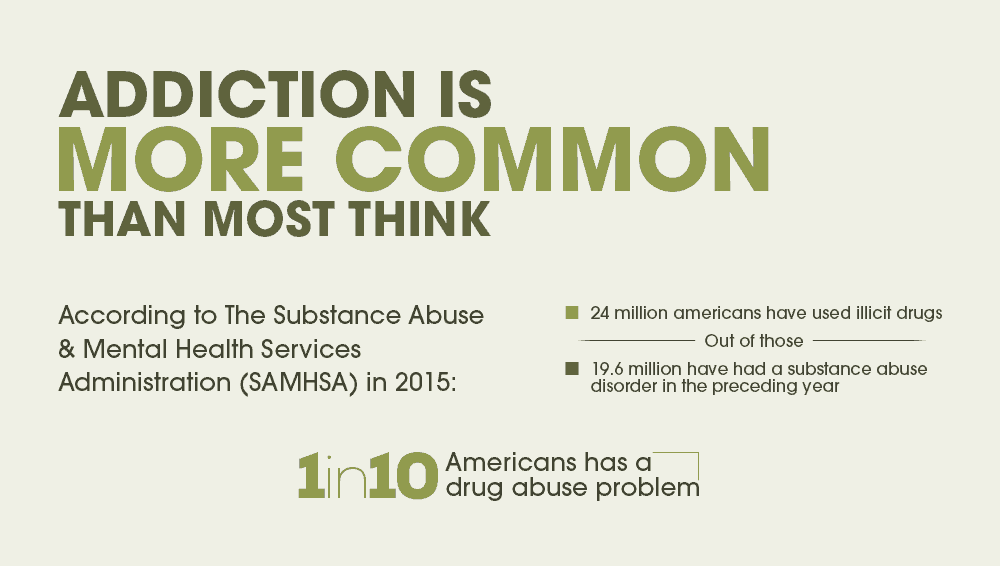 The most recent census on drug addiction shows that at least 24 million Americans (9.4%) have used illicit drugs in the preceding month. Of these, approximately 19.6 million have, or have had, a substance abuse disorder in the preceding year. This means that nearly one in every ten Americans has a drug abuse problem – a statistic that would surprise many. After a steady decline in drug addiction during the early millennium, substance abuse has sharply inclined over the last ten years. Compared to 2015’s estimate of 24 million monthly drug users, 2007’s census recorded only 19.9 million. [1]
The most recent census on drug addiction shows that at least 24 million Americans (9.4%) have used illicit drugs in the preceding month. Of these, approximately 19.6 million have, or have had, a substance abuse disorder in the preceding year. This means that nearly one in every ten Americans has a drug abuse problem – a statistic that would surprise many. After a steady decline in drug addiction during the early millennium, substance abuse has sharply inclined over the last ten years. Compared to 2015’s estimate of 24 million monthly drug users, 2007’s census recorded only 19.9 million. [1]
“Our 28-Day Drug Rehab Program has helped many overcome their addiction – We take various forms of insurance.”
Statistics on the Prevalence of Different Substances of Abuse
Legal and less-stigmatized drugs (alcohol and marijuana, particularly) unsurprisingly make up a large percentage of the addicted population. Divided according to 2015’s census, drug abuse is split mostly among the following:
- Alcoholics comprise a massive 15.4 million of substance abusers
- Marijuana smokers comprise 4 million (though marijuana is not generally considered to be an addictive drug, abstaining from it can be difficult.)
- Users of other all other illegal drugs combined make up 7 million
- Prescription drug abusers comprise 2.4 million
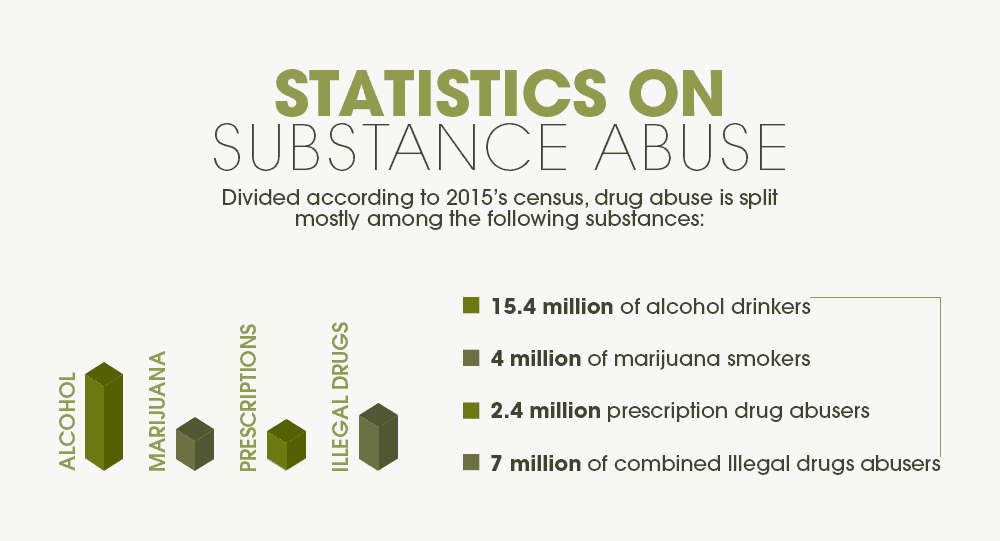 America’s drug problem is comparatively large to the rest of the world. There are a recorded 230 million drug addicts worldwide according to the Huffington Post. This means that America is home to more than a tenth of them. By contrast, only 2.9 % of Japan’s population has used illegal drugs in the year, compared to 9.4% of Americans have done so in the last month. In Portugal, the first country in which drugs have been almost entirely decriminalized, only 8% of the population has resorted to illicit drug usage in the year of. 2015.[2][3]
America’s drug problem is comparatively large to the rest of the world. There are a recorded 230 million drug addicts worldwide according to the Huffington Post. This means that America is home to more than a tenth of them. By contrast, only 2.9 % of Japan’s population has used illegal drugs in the year, compared to 9.4% of Americans have done so in the last month. In Portugal, the first country in which drugs have been almost entirely decriminalized, only 8% of the population has resorted to illicit drug usage in the year of. 2015.[2][3]
Ethnic and Cultural Diversity Among Substance Abusers
The disease of addiction is distributed differently among different ethnic groups within the United States. Environmental, personal, educational, and community standards among people of different cultures can be contributing factors as to whether or not its members will use drugs.
- 7% of African-Americans, who comprising 13% of the population, have recently used drugs.
- 11% of Native Americans, at 0.7% of the total population, have recently used drugs.
- 6.5% of Caucasians, who comprise 40.5% of the population, recently used drugs.
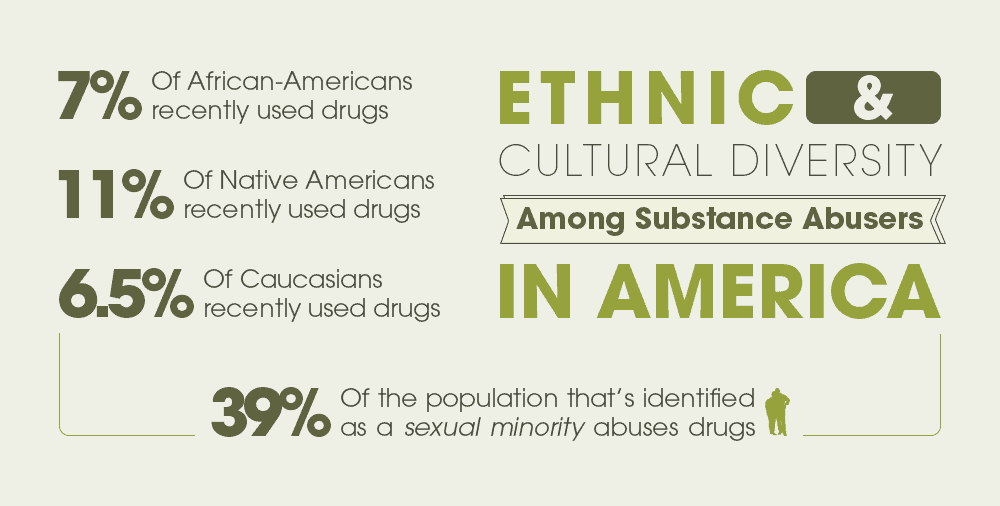 It appears that those who identify as a sexual minority – essentially, anyone who doesn’t label themselves a heterosexual (which 94% of the gross population does,) suffer a higher risk of developing substance abuse disorders. 39% of the population that identified as a sexual minority abuses drugs – a much higher percentage than that of any ethnic minority. Of these sexual minorities (bisexual, homosexual, and sexually undecided,) one in every three men and nearly one in every five women are recent drug abusers. [4]
It appears that those who identify as a sexual minority – essentially, anyone who doesn’t label themselves a heterosexual (which 94% of the gross population does,) suffer a higher risk of developing substance abuse disorders. 39% of the population that identified as a sexual minority abuses drugs – a much higher percentage than that of any ethnic minority. Of these sexual minorities (bisexual, homosexual, and sexually undecided,) one in every three men and nearly one in every five women are recent drug abusers. [4]
The Mentally Ill: The Backbone of America’s Substance Abuse Issue
Almost half of America’s substance abusers are also victims of mental disorders, or have developed them as a result of excessive drug use. Of 19.6 million adults with substance use disorders, 8.1 million of them had mental illnesses. This comes from a population of only 35.4 million Americans afflicted by mental illnesses – meaning that almost a quarter of mentally unwell Americans abuse drugs. Summarized, we can see that a whopping 2.3% – over one in fifty – of the total American adult population, is struggling with co-occurring drug dependencies and mental illnesses.[5] 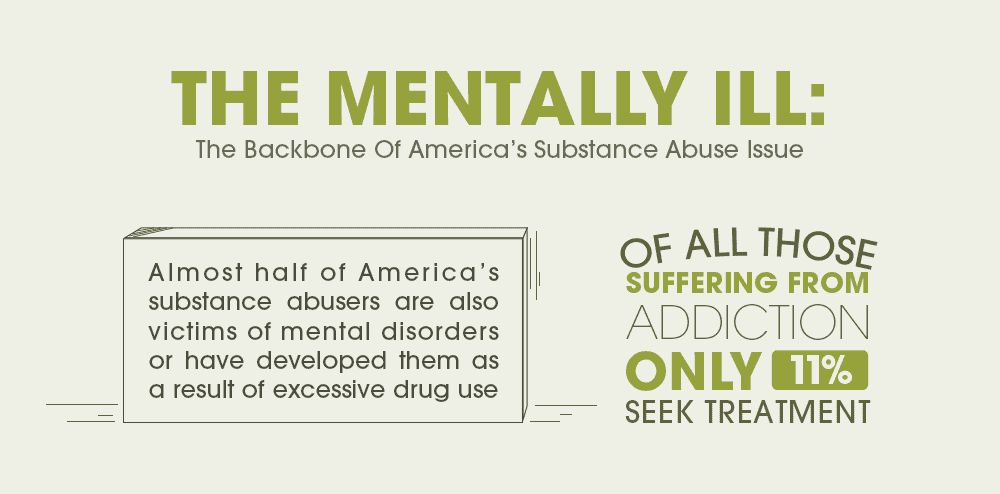 There are addictions that run rampant as well, beyond those that are considered substance abuse issues by the DSM-IV.
There are addictions that run rampant as well, beyond those that are considered substance abuse issues by the DSM-IV.
- Nicotine addiction, which can cause a physical dependence similar to other abused substances, has taken 55.1 million Americans.
- Up to thirty percent of Americans might regularly drink more than six cups of coffee a day. eleven percent of America is addicted to sex, two percent is addicted to food, and two percent is addicted to gambling.
Of all those suffering from drug addiction, only eleven percent seek treatment. This doesn’t mean that substance abusers don’t want help – the high cost of treatment is a deterrent to many addicts who are unable to support themselves enough to pay for a treatment plan. This contributes to America’s continually escalating rate of drug addiction. Without viable treatment alternatives for the frequently low-income demographics of substance abusers and proper concern to address the underlying societal issues that result in drug use, the problem will only continue to spread.
What Did you Think About This Blog?
Give it a Rating!
Full Infographic:
 https://www.drugabuse.gov/publications/drugfacts/nationwide-trends https://www.thecabinchiangmai.com/statistics-of-japan-s-rising-drug-use/ https://www.drugpolicy.org/sites/default/files/DPA_Fact_Sheet_Portugal_Decriminalization_Feb2015.pdf https://northpointwashington.com/blog/sick-addicted-substance-abuse-among-people-serious-illnesses/ https://www.addiction.com/4249/sex-among-top-10-addictions/
https://www.drugabuse.gov/publications/drugfacts/nationwide-trends https://www.thecabinchiangmai.com/statistics-of-japan-s-rising-drug-use/ https://www.drugpolicy.org/sites/default/files/DPA_Fact_Sheet_Portugal_Decriminalization_Feb2015.pdf https://northpointwashington.com/blog/sick-addicted-substance-abuse-among-people-serious-illnesses/ https://www.addiction.com/4249/sex-among-top-10-addictions/


